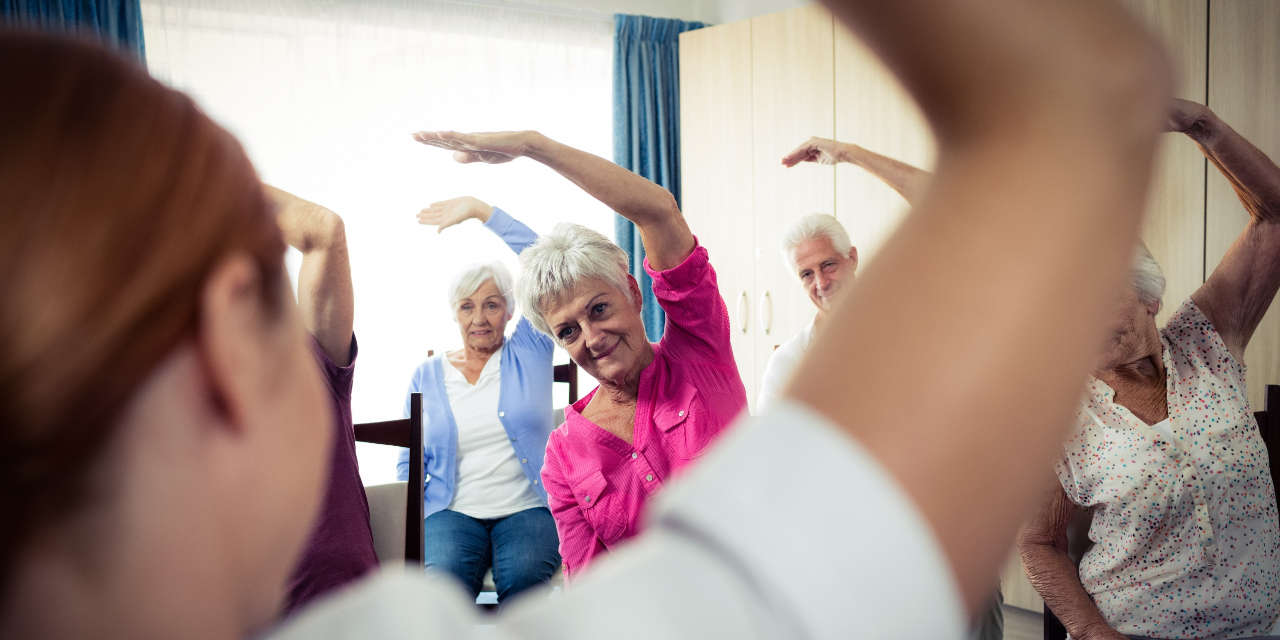By Ben Broadhead
I’m a personal trainer specializing in working with seniors. In this article, I will give my perspective on strength training for older adults and how you can best implement it into an activity program in your senior living community. I hope it’s of benefit to you.
What Strength Training Does for Seniors
The reason I advocate for strength exercise so strongly is because I’ve seen firsthand how it translates into everyday functionality. For seniors, this means being able to undertake tasks of daily living with less friction and to hold onto their independence.
The best part of my job is having my clients report back to me about how much easier it is for them to walk up the stairs or how they can carry their shopping inside in one trip.
As you may know, past the age of 30, we undergo age-related muscle atrophy known as sarcopenia. This causes a gradual decline in muscle mass and strength. Fortunately, we can offset or even reverse this process with resistance training. The benefits include not only increased functionality and independence but also fall prevention and the management of conditions like arthritis and osteoporosis.
For these reasons, I believe that organized strength training should be available to anyone over 65, particularly in community settings. Implementing this into your activity program will demonstrate a holistic approach to residents’ wellbeing, setting you apart from other communities. And more importantly, it will keep your residents happy and healthy.
Misconceptions
In my work, I encounter misconceptions about strength training for seniors. Here are a couple:
Myth: Strength training is only relevant to bodybuilders and athletes.
Fact: Each muscle in our body has a functional purpose. Maintaining these functions requires frequent and significant muscular stimulus.
Myth: We cannot increase our strength beyond a certain age.
Fact: While we do experience decreased levels of protein synthesis and growth hormone with age, we maintain the ability to make significant improvements to our strength. This is particularly true for novices because they are starting from ground zero. My clients are a testament to this fact, and I have the good fortune of witnessing their progressions every day.
Improvements can be achieved by remaining consistent and progressively overloading. This means to gradually increase the intensity of the workout, either by doing more repetitions; using greater resistance; or adding another new element of challenge, such as a pause or slowing the pace of the movements.
How to Make Residents Want to Come (and Come Back)
A good start is to offer strength-focused, seated exercise classes for your residents. These can be fun and social, in addition to having physical benefits. They can be done in the communal area using dining chairs. A more upright and firm chair is optimal, compared to an armchair or couch.
You will undoubtedly come up against some reluctance to exercise from certain residents. You can overcome this issue in several ways:
- Don’t call it exercise. Everyone has their own preconceived idea of what that looks like. Say you’re going to do some activities or mobility together, which will feel less intimidating.
- Use equipment. Bodyweight exercises are a good starting point and lower the barrier to entry for beginners. As the group becomes familiar with the movements, however, you can introduce some equipment. Having something physical to interact with can result in greater levels of engagement, particularly for those with dementia. The main two pieces of equipment that I use are resistance bands and sponge balls. However, you can just as easily use other objects, like balloons or beanbags, for games and coordination-based activities.
- Play music. This will keep things fun and increase class attendance going forward. I generally play music from the ’50s and ’60s, which I know will be nostalgic for them and receive a positive response.
- Remember that excessive soreness will deter residents from taking part next time, because they won’t necessarily understand that it is a normal byproduct of resistance training. Stretching at the end, therefore, is very important. You can even do some breathwork at the same time to help the group relax and feel refreshed.
- Prioritize safety. Fears and apprehensions among beginners are very common. One that stands out is the fear that it will be too intense and will cause injury. As long as participants work within their limitations and perform each movement with proper technique, the likelihood of injury is very small. It’s also important that progress be incremental. Safety has to take priority over effectiveness during strength sessions.
- You will have some residents who either dislike group environments or cannot engage in group classes due to physical limitations. In these instances, you may choose to provide some one-on-one exercise sessions to give them the opportunity to participate. Even if they are bedbound, there are plenty of exercises that you can have them do — for example, leg raises, arm raises, or rows with the resistance band.
You may be reading this and thinking that your residents ought to do some cardiovascular exercise to improve their respiratory function and heart health. My experience has taught me that, actually, a 30-minute strength session provides ample cardiovascular stimulus for someone of that age. Therefore, cardio doesn’t necessarily have to be addressed directly, and doing so may pose more risk than benefit.
Session Structure
Here’s the structure I use:
- Start with a mobility-based warm-up, to loosen the joints and activate the muscles. The warm-up is crucial, as it gives the body time to adapt to the stimulus of exercise and decreases the likelihood of injury.
- Move on to the strength exercises. I mix these up with some more explosive exercises, like punches to challenge muscular power, and others to increase endurance, like high knees.
- Wind down with some static stretches for all of the muscle groups that we’ve worked on in the session. This gradually brings the heart rate back to baseline and reduces the amount of soreness the group will feel the following day.
You want to ensure that your class covers all of the major muscle groups in the body. You may, however, choose to place more emphasis on particular areas of weakness. I tend to prioritize the legs and back, as these atrophy quicker than other muscle groups and have transferability into balance and fall prevention.
Whichever exercises you choose, the main thing is that you are comfortable teaching them and that they are appropriate for the ability level and needs of the group.
The National Health Services in the UK (where I live) recommends that, over the age of 65, we aim to engage in strength exercises at least two times per week. I personally think that three is ideal if you can manage it.
Diet and Rest
I ought to mention diet and rest because they are such key components of increasing muscle mass and strength.
Weight training alone doesn’t build muscle. It actually creates microbes in our muscle fibers, which are repaired when we rest and eat, particularly when we eat protein. Consumption of protein initiates what’s called protein synthesis, where muscle fibers are repaired in such a way that makes them bigger and stronger. This is our body’s way of adapting to a new set of challenges that we’ve placed on it.
I encourage my clients to have one good protein source with each meal. This is a really easy way to keep on top of it. So, for example, yogurt or eggs for breakfast would be a good option, as opposed to cereal, which is mainly carbohydrates. Protein sources can include meat, fish, dairy, eggs, nuts, tofu, and pulses like chickpeas and kidney beans.
Summary
- Select exercises that are suitable for the ability level of your group.
- Progressively overload over a period of time.
- Find ways to make the sessions fun and engaging.
- Ensure that residents are getting ample rest and proper food intake to support their exercise routine.
Good luck!
Ben Broadhead is a mobile personal trainer from Cookham, England. He specializes in working with older adults and offers live classes here. In 50 Exercises for Older Adults, Ben lays out his top picks for effective, relevant exercises for seniors.







